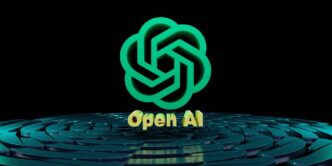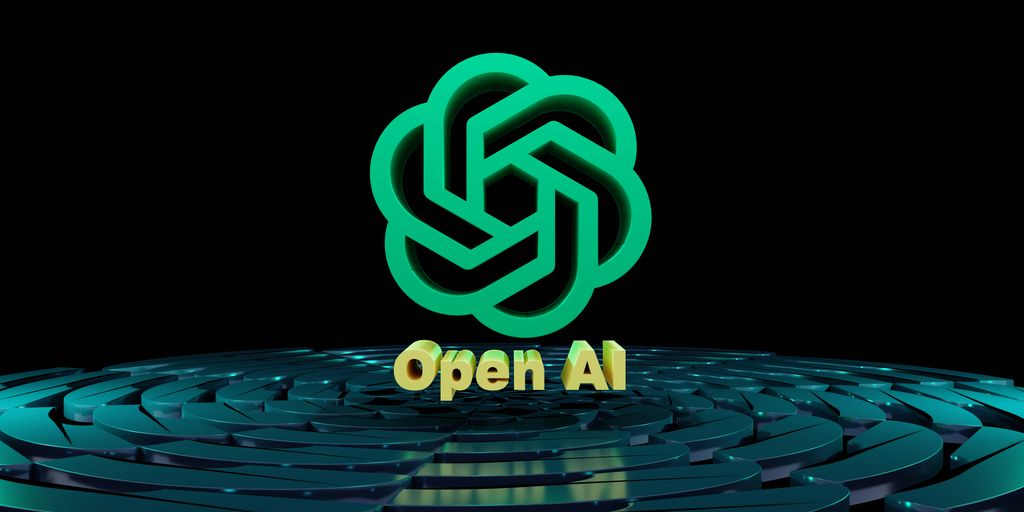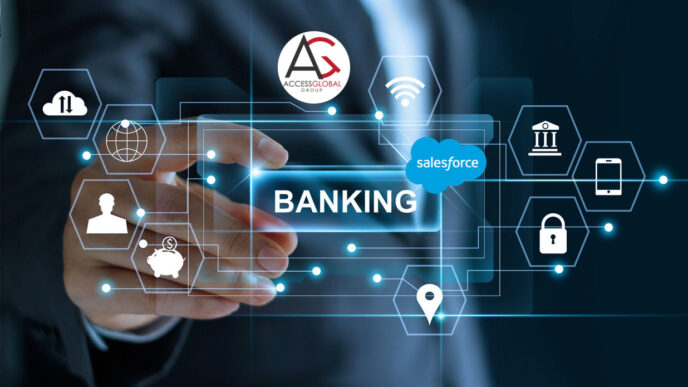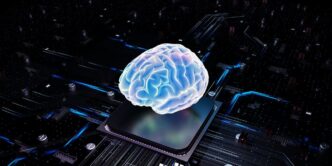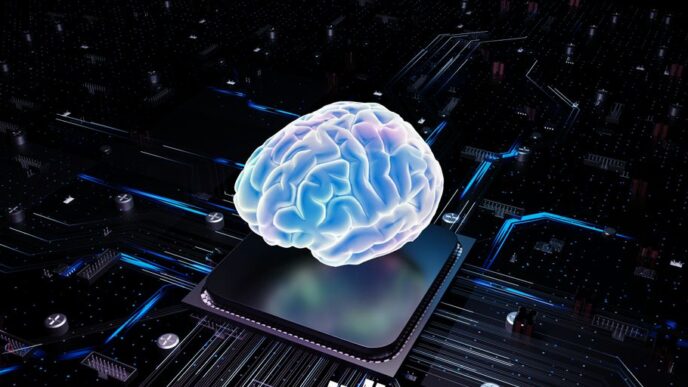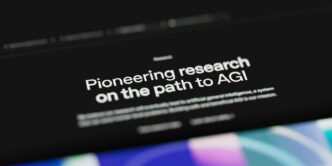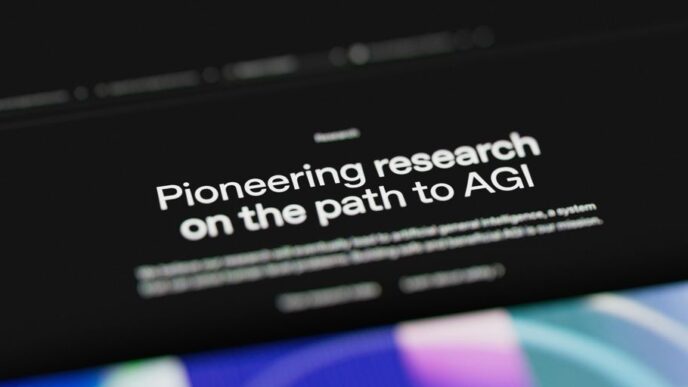It’s been a busy time for open ai and microsoft news lately. The partnership between these two tech giants is always evolving, and there’s a lot happening under the hood. From massive investments to strategic shifts, it feels like things are constantly changing. We’re seeing how their initial collaboration is shaping up and what it means for the future of AI. Let’s break down some of the latest developments.
Key Takeaways
- Microsoft’s significant investment and exclusive distribution rights have been central to OpenAI’s growth, providing essential infrastructure and market access.
- Tensions have emerged, with OpenAI seeking more autonomy and Microsoft exploring broader AI support on Azure, leading to overlapping product offerings.
- Disagreements over revenue sharing and specific clauses in their partnership agreement are points of negotiation as both companies pursue their own strategic goals.
- OpenAI aims to be the ‘Everything Platform’ for AI, building a foundational layer for various applications, while Microsoft sees Azure as the core infrastructure for AI development and deployment.
- Real-world applications show companies across industries using Azure AI and OpenAI services to innovate, improve customer experiences, and drive operational efficiency.
The Evolving Open AI and Microsoft Partnership
Foundational Alliance and Early Investments
Back in July 2019, a significant partnership kicked off between OpenAI and Microsoft. This wasn’t just a casual collaboration; it was a deep dive into building advanced AI, with the ultimate goal of achieving Artificial General Intelligence (AGI). Microsoft’s commitment was substantial, reportedly investing $1 billion initially. This move essentially made Microsoft the exclusive cloud provider for OpenAI, with the company’s operations and model training happening on Microsoft Azure. In exchange for this massive backing and infrastructure, Microsoft secured a significant stake in OpenAI’s future profits, reportedly getting about 49% of the earnings from OpenAI’s for-profit arm, capped at a 10x return on their investment. It was a bold move, setting the stage for what many thought would be a long and fruitful relationship.
Microsoft’s Strategic Role and Economic Stakes
Microsoft’s involvement goes way beyond just providing cloud services. They’ve become deeply intertwined with OpenAI’s success, both strategically and financially. The deal structure is pretty unique: Microsoft gets a substantial cut of OpenAI’s revenue, reportedly 20% up to a certain threshold, while also receiving a portion back (20%) when they sell OpenAI-powered services through Azure. This dual revenue stream highlights how critical OpenAI’s technology is to Microsoft’s cloud business. Microsoft’s massive enterprise sales force and existing Azure customer base effectively became OpenAI’s primary distribution channel, allowing OpenAI’s powerful AI models to reach businesses worldwide through services like the Azure OpenAI Service. This symbiotic relationship meant Microsoft was not only investing in a cutting-edge AI company but also securing a competitive edge in the rapidly growing AI market.
Exclusive Distribution and IP Rights
Part of the initial agreement granted Microsoft some pretty significant advantages regarding intellectual property. For a set period, extending to 2030, Microsoft has broad rights to use and deploy OpenAI’s models and research. This means Microsoft can integrate OpenAI’s latest advancements into its own products without worrying about OpenAI offering the same capabilities to a direct competitor. This exclusivity was a major draw for Microsoft, ensuring they could capitalize on OpenAI’s innovations before anyone else. It solidified Microsoft’s position as the go-to partner for OpenAI, creating a strong, albeit exclusive, bond that shaped how OpenAI’s technology reached the market.
Navigating Tensions and Strategic Divergence

It hasn’t all been smooth sailing for OpenAI and Microsoft, despite their deep ties. The partnership, while powerful, has also seen its share of bumps and disagreements, forcing both sides to adjust their strategies. It’s a complex dance, balancing shared goals with individual ambitions.
Governance Crises and Microsoft’s Intervention
OpenAI’s internal structure has been a source of instability. The dramatic firing of Sam Altman in late 2023, followed by the departure of key safety leaders like Ilya Sutskever and Jan Leike, highlighted significant governance issues. These events weren’t just internal squabbles; they had real-world implications for the company’s direction and its relationship with partners. Microsoft, having invested billions, naturally had a vested interest in stability. Reports suggest Microsoft played a role in Altman’s eventual return, underscoring their influence when things got shaky. This period also saw a notable exodus of talent, with over 50 senior researchers and a quarter of its leadership leaving within two years. Some went to startups, while others, like several key GPT-4 scientists, were reportedly hired by competitors such as Meta. This brain drain, coupled with funding pressures – like needing to complete a for-profit conversion by the end of 2025 to keep a significant portion of its funding – created a volatile environment.
Shifting Strategies and Emerging Competition
As AI rapidly evolves, so do the strategies of the major players. OpenAI is pushing its vision of an "Everything Platform," aiming to be the central hub for AI interactions. This involves building out consumer and enterprise applications, and fostering a developer ecosystem. However, this ambitious plan faces stiff competition. Google is integrating its AI across its vast product suite, Meta is pushing an open-source approach, and other companies are developing their own advanced models. This competitive landscape means OpenAI can’t afford to stand still. The risk of its core model capabilities becoming less unique, or commoditized, is real. Companies like DeepSeek are already offering alternatives, potentially driving down prices and squeezing OpenAI’s margins if they can’t continuously demonstrate superior value. Maintaining a competitive edge requires constant investment in talent, new model architectures, and securing access to computing power, potentially even through proprietary hardware.
OpenAI’s Pursuit of Autonomy and Multi-Cloud
While Microsoft has been OpenAI’s primary backer, providing essential compute power and distribution channels, this dependence also creates friction. OpenAI is reportedly exploring ways to gain more independence, including diversifying its cloud infrastructure beyond Microsoft Azure. This move towards a multi-cloud strategy could be seen as a way to reduce reliance on a single partner and potentially negotiate better terms. It also aligns with a broader ambition to make its AI models accessible across various platforms, not just those tied to Microsoft. This pursuit of autonomy is understandable, especially given the significant economic stakes involved. Microsoft’s initial deal reportedly grants them nearly half of OpenAI’s profits, a structure that might become a point of contention as OpenAI’s revenue grows. Furthermore, there’s the ongoing discussion around the "AGI clause," a key part of their agreement that secures Microsoft’s access to OpenAI’s future artificial general intelligence models. Renegotiating such clauses is common in evolving partnerships, and it’s a critical area for securing ongoing collaboration.
Key Points of Contention in the Partnership
It’s not all smooth sailing between OpenAI and Microsoft, even with their deep ties. There are some pretty significant disagreements bubbling up, mostly around money and control, which is kind of expected when you have this kind of massive collaboration.
Revenue Sharing Disagreements
So, OpenAI is looking at the deal and thinking that the 20% cut Microsoft gets from their revenue is just too much. They feel it’s holding them back from putting more money into research and development. They’ve even floated the idea of giving Microsoft more ownership in the company instead of that big revenue slice. It’s a classic tug-of-war: OpenAI wants to keep more cash for itself to grow, while Microsoft wants its substantial return on investment.
The ‘AGI Clause’ and Future Rights
There’s this interesting part of their original agreement, often called the ‘AGI Clause.’ Basically, if OpenAI manages to create Artificial General Intelligence (AGI), the deal says Microsoft’s share of profits and rights to their technology would just… stop. Microsoft, understandably, isn’t too keen on this and is trying to get that clause changed or removed entirely during their current talks. It’s all about securing their stake in what could be the biggest technological breakthrough ever.
Microsoft’s Veto Power and Restructuring Influence
Microsoft has some serious say in major decisions thanks to the partnership agreements. This includes having veto power over big changes, like OpenAI’s planned restructuring that’s supposed to happen by the end of 2025. Microsoft can use this power to push for terms that are more favorable to them. It’s a clear sign of how much influence Microsoft wields, even as OpenAI tries to chart its own course.
Open AI’s Ambitious Platform Vision
OpenAI isn’t just building AI models anymore; they’re aiming to create the entire AI ecosystem, sort of like how Google owns search or Amazon owns online shopping. They call this the "Everything Platform" strategy. The idea is that eventually, all sorts of AI-powered stuff, from apps to services, will be built on top of what OpenAI provides. It’s a pretty big vision, especially since they believe Artificial General Intelligence (AGI) will be the most important technology ever. They want to be the central hub where all these different AI capabilities come together.
The ‘Everything Platform’ Strategy
Think of it like this: remember when the internet first took off? Companies that controlled the platforms – like Google for search or Facebook for social stuff – ended up capturing a huge amount of value. OpenAI sees a similar opportunity with AI, but on an even grander scale. They want to be the main way people and businesses interact with intelligence itself. It’s a massive undertaking, and they’re already seeing huge growth, with projections showing significant revenue increases in the coming years. This strategy is all about building a foundation that others can build upon, making OpenAI essential for the future of AI.
Driving Value Across User Segments
What’s interesting is that OpenAI is trying to serve everyone at once – regular consumers, businesses, and developers. This is different from older tech companies that usually focused on either consumers or businesses. AI makes it possible for one platform to do both. For businesses, AI is moving from just being a test project to becoming a core part of how they operate. The market for AI in businesses was already billions of dollars in 2024 and is expected to grow a lot more by 2030. By catering to all these different groups, OpenAI hopes to create a powerful network effect.
Leveraging Data Network Effects
This whole platform approach is designed to create what’s called a network effect, especially with data. The more people use OpenAI’s services, the more data they collect. This data helps improve their AI models, making them better for everyone. Better models attract more users, who then generate more data, and the cycle continues. It’s a bit like a snowball rolling downhill. This flywheel effect is what helps them stay ahead of competitors and build a strong position in the market. It’s a smart way to build loyalty and make it harder for others to catch up.
Microsoft’s Azure as the AI Infrastructure Backbone
When you think about how OpenAI’s advanced AI models get built and then actually used by businesses, you can’t ignore Microsoft’s role. It’s like Azure is the massive engine powering all of this. Microsoft isn’t just a partner; they’re providing the actual digital real estate and the super-powered computers that OpenAI needs to train its models and then run them for everyone else.
Fueling OpenAI’s Compute Needs
Training models like GPT-4 takes an unbelievable amount of computing power. We’re talking about thousands of specialized chips working together for weeks or even months. Microsoft’s Azure cloud provides exactly this kind of massive, scalable infrastructure. It’s not something most companies could build themselves. This setup allows OpenAI to push the boundaries of what’s possible with AI, constantly improving their models without worrying about hitting a hardware limit. It’s a pretty big deal for their research and development.
Enabling Enterprise-Scale Distribution
Once the models are ready, getting them into the hands of businesses is the next big step. This is where Azure really shines again. Microsoft’s existing relationships with companies worldwide, combined with Azure’s global network, make it possible to offer OpenAI’s technology to businesses of all sizes. Think about it: instead of each company building its own AI system, they can tap into OpenAI’s capabilities through Azure. This makes advanced AI accessible and practical for everyday business use. Companies can even run OpenAI’s gpt-oss models on their own terms, giving them more control.
Azure OpenAI Service Integration
The Azure OpenAI Service is the main way this partnership comes to life for customers. It’s a managed service that gives businesses access to OpenAI’s powerful models, like GPT-4, but within the secure and familiar environment of Azure. This means companies can build AI-powered applications without needing to be AI experts themselves. They get the benefits of cutting-edge AI, plus the security, compliance, and data handling features that Azure is known for.
Here’s a look at how some companies are already using this:
- Schneider Electric: Uses a range of AI tools to speed up its own innovation and help customers do the same.
- Accenture: Built a centralized solution for secure generative AI development, cutting down build times by half.
- MediaTek: Migrated to Azure and used AI Foundry models, seeing a 50% faster AI processing speed.
- Mitsui & Co.: Is using generative AI to make its security operations center more efficient, handling lots of alerts with better accuracy.
This integration is key because it bridges the gap between OpenAI’s groundbreaking research and the practical needs of businesses looking to adopt AI.
Real-World Impact: Enterprise Integrations and Innovations

It’s pretty wild to see how AI, especially with the OpenAI and Microsoft connection, is actually changing how businesses work day-to-day. We’re not just talking about futuristic ideas anymore; companies are using this stuff right now to get things done better.
Transforming Industries with Azure AI
Lots of companies are jumping on board with Azure AI. Think about manufacturing – places like Schaeffler are using AI to keep their machines running longer and make sure their workers are more productive. They’re getting real-time info from all sorts of systems, which is a big deal for keeping things smooth. Then there’s the automotive world; Volkswagen, for instance, is using Microsoft’s tools to handle the crazy complexity of building modern cars. It’s helping them manage everything from design to the final product.
Enhancing Customer Experience and Operations
It’s not just about making factories run better, though. Companies are also using AI to connect with their customers in new ways. Sheló NABEL, for example, has seen a big jump in sales after using Microsoft Dynamics 365 and Copilot. They’re managing their products better and can get reports done way faster, which means they can make smarter choices about what to sell and when. This kind of improvement helps them serve their customers, who are often independent sellers, much more effectively.
Driving Innovation Through AI Adoption
And then there’s the innovation side of things. AI is really speeding up how companies come up with new products. In fields like aerospace, companies are using tools like GitHub Copilot to write code faster, and they’re even putting AI applications onto satellites to process data right there in space. NASA has its own project, Earth Copilot, to make it easier for people to work with data about our planet. Even in farming, there are AI apps helping farmers make better decisions about crops and dealing with weather issues. It’s clear that AI is becoming a tool for creating new solutions and improving existing ones across the board. You can find more examples of how businesses are changing with AI in customer success stories.
Here’s a quick look at some of the benefits companies are seeing:
- Better efficiency: Automating tasks frees up employees for more important work.
- Improved customer interactions: More personalized experiences for customers.
- Smarter decision-making: Faster access to data and insights.
- Faster product development: Cutting down the time it takes to bring new ideas to market.
The Future Landscape of AI Collaboration
Looking ahead, the whole AI collaboration scene is pretty interesting, and honestly, a bit of a wild ride. OpenAI’s aiming to be this massive "Everything Platform," which is a huge goal. Think about it – they want to handle everything from the supercomputing power needed to train these models, all the way to consumer products and enterprise software. It’s like trying to build the entire internet, but for AI, and doing it all at once. This is a big shift from their early days as a research lab. The market for AI is exploding, kind of like the internet did years ago, but way faster. What’s neat is that AI can work for both businesses and regular people, unlike older tech that usually had to pick a side. Businesses are already using AI for important stuff, not just experiments. The AI market was about $24 billion in 2024, and people think it’ll hit $155 billion by 2030. That’s a lot of growth.
But this broad approach isn’t without risks. Trying to do everything at once could mean losing focus. We’re seeing companies like Anthropic, started by former OpenAI folks, really pushing ahead with their own models, like Claude 4, which is apparently great for coding. They’re not just making a tool; they’re building a whole system for developers, which is a smart move. OpenAI’s current strengths are its top-tier models, its huge user base with ChatGPT, and its Microsoft partnership. But these strengths are being challenged from all sides. Other big AI labs, open-source projects, and major tech companies are all trying to grab a piece of the pie.
OpenAI’s financial situation is also a big part of the story. They’re spending billions, way more than they did as a non-profit. Even with growing revenue, they’re still losing money, like $5 billion in 2024, and don’t expect to be profitable until 2029. A lot of that cost is for talent and computing power. They’ve grown from under 800 employees to around 3,000 in just over a year, which shows how much they’re expanding to become this full-stack platform. They’ve got teams working on new models, turning those models into products like ChatGPT, and then adapting those products for different industries. It’s a massive undertaking.
Here’s a quick look at how AI is already making a difference:
- Aeronautics: Loft Orbital uses AI to process data from space in real-time, and NASA has an "Earth Copilot" to help people work with Earth data.
- Agriculture: In the Philippines, an app called AgriConnect uses AI to help farmers manage resources and deal with weather issues. Another service helps fish farmers with better data.
- Employee Experience: Companies are seeing big productivity boosts by using AI to handle boring tasks, freeing up employees for more creative work. This also seems to make people happier at their jobs.
- Cable & Satellite: EchoStar Hughes created 12 new apps using AI, expecting to save 35,000 work hours and increase productivity by 25%.
- Education: Schools are using AI tools to help teachers save time, with some reporting an average of 9.3 hours saved per week.
The big question is whether OpenAI can keep its lead while expanding so rapidly, or if this push to be everything to everyone will spread them too thin. It’s a balancing act, for sure.
Looking Ahead: The Evolving Partnership
So, what does all this mean for the future? The partnership between OpenAI and Microsoft is clearly still a big deal, but it’s not exactly smooth sailing anymore. We’re seeing them both grow and change, sometimes in ways that put them at odds. Microsoft is building out its own AI tools and even looking at other AI partners, while OpenAI is trying to gain more independence. It’s a complex dance, with both companies needing each other but also looking out for their own interests. We’ll have to keep an eye on how this relationship plays out, especially with big goals like AGI on the horizon. It’s going to be interesting to see if they can keep working together effectively or if their paths will diverge more significantly.

